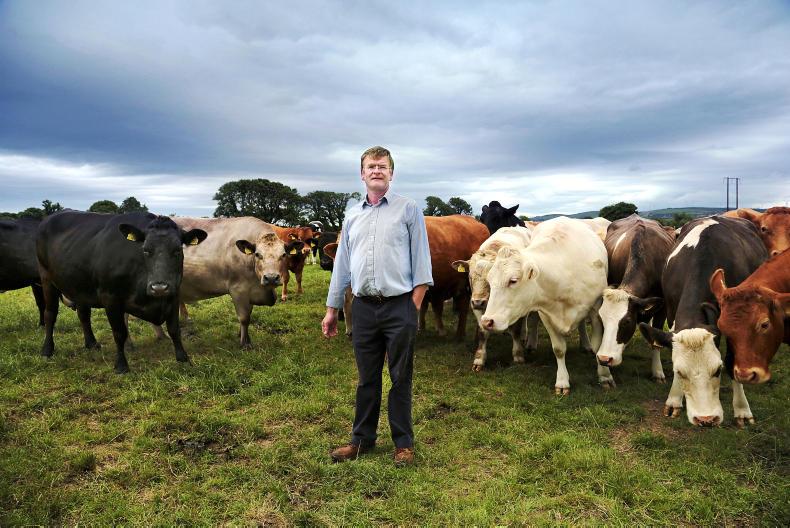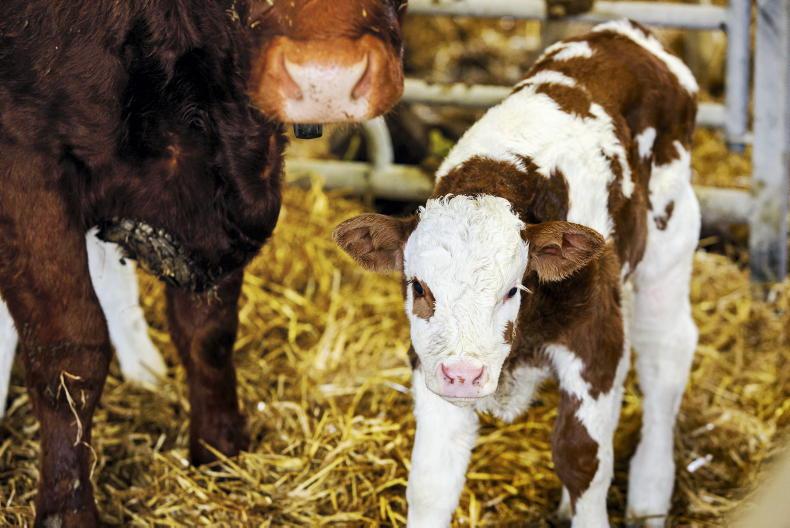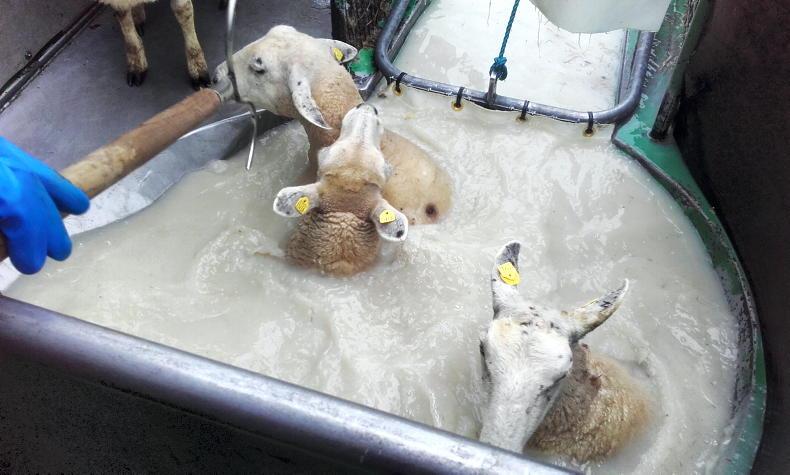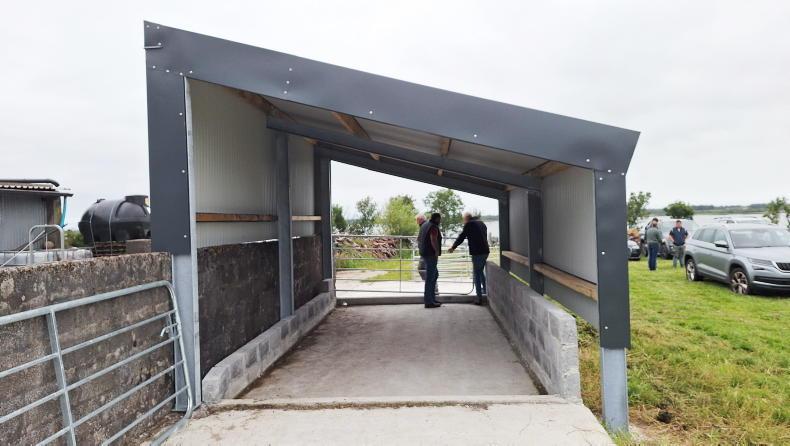While most of the herds in the BETTER farm programme calve in spring, there are a number of farms operating successful autumn-calving systems.
Autumn calving is traditionally seen as being higher cost and requiring a higher labour input, but the system can bring a lot of benefits in terms of facilitating easier use of AI, calving outdoors at a more favourable time of year and having heavier weanlings for sale in early autumn. It also fits in well with certain finishing systems, particularly the under-16-month bull system, where it can allow for a large proportion of cheap weight gain from grass.
Feed cost
The biggest extra cost associated with autumn calving is feeding of the cow and calf. While the spring cow calving straight to grass can be maintained during the indoor period on a diet of moderate-quality silage (65% to 68% DMD), an autumn-calving cow has to provide adequate milk to rear a calf and get back in calf to maintain her 365-day calving interval while indoors.
For this to be achieved, a diet of top-quality silage (72%+ DMD) along with 1kg to 2kg of concentrates and minerals for the breeding season is required to provide the cow with enough energy to achieve these targets.
While indoors, autumn calves may also require ration at a rate of 0.5kg/day over the winter period. In comparison, spring calves require no ration once grassland management is adequate and creep grazing is practised up to weaning.
For the purposes of comparison, the costs of two contrasting BETTER Farm participants, both of whom have made substantial improvements in their profitability, are compared.
Comparison
Our spring-calver is David Walsh, who runs a spring herd of 55 cows near Clonmel, Co Tipperary, on heavy land located almost 900 feet above sea level.
David’s direct cost of keeping a cow comes in at €628. The vast majority of this goes on feed. Despite feeding no meal and typically having a four-month winter, the cow is costing €407.50 alone to feed.
Weanling costs come in at €36.25 per head, despite needing only a very small amount of meal after weaning.
Our autumn-calver is Mike Dillane from near Lixnaw, Co Kerry. Mike runs a 110-cow autumn-calving herd on very heavy, low-lying land, some of which was reclaimed bog. The autumn system suits Mike’s farm. Taking the heavy nature of the soil, turnout in spring is often an issue, with an average turnout date of mid-April. Mike typically has a five-month winter, although this hits six months in very bad years.
While turnout date can be late, Mike is still able to make top-quality silage by cutting in late May each year. Mike typically achieves 70% to 73% DMD silage crops and this keeps his meal requirement relatively low.
Mike’s cow-calf unit costs €768.25 per year. The main difference between Mike’s and David’s farms is that Mike has to feed €40.25 worth of meal over the winter along with cows consuming around 0.2t of silage extra per month during the winter period. This is necessary to provide sufficient energy for production. Total feed costs come to €445.75/head.
Vet and weanling cost
Vet costs on the farm are similar to David’s at €67/head, but weanling costs are higher due to a meal input into the calves over their first winter and a higher grazing cost – the calf is larger and utilises more grass in the spring.
Replacement costs on Mike’s farm are negligible due to cull cows making strong prices, comparable to replacement heifer value.
While the autumn system has higher costs, it should be noted that calves are better able to utilise grass once turned out and achieve good weight gain cheaply.
Cows can be restricted on poorer-quality pasture during the dry period and can be used to follow up behind calves, thus eliminating the need for topping. The use of AI in the winter facilitates the use of top sires. Calf weights will also be higher by early-autumn, with calves commanding higher prices at the ringside.
Guide to the costs
Grazing costs: €0.80 daily for autumn-calving cow and €1 daily for spring-calving cow.Bull costs: assuming an initial bull cost of €4,000, an annual maintenance cost of €650, a salvage value of €2,000, five years in the herd and 30 cows served per year.Replacement costs: Mike Dillane achieved €1,400 for cull cows in 2015, which was the value of his replacement heifers. David Walsh replaces 20% of his 55-cow herd annually. Replacements cost €1,200. He achieves a cull cow price of €1,100 and operates on a cow mortality figure of 1%. Days at grass are 240 and 210 for David Walsh and Mike Dillane respectively.![]()
Click on the table to download the full-size version.
While most of the herds in the BETTER farm programme calve in spring, there are a number of farms operating successful autumn-calving systems.
Autumn calving is traditionally seen as being higher cost and requiring a higher labour input, but the system can bring a lot of benefits in terms of facilitating easier use of AI, calving outdoors at a more favourable time of year and having heavier weanlings for sale in early autumn. It also fits in well with certain finishing systems, particularly the under-16-month bull system, where it can allow for a large proportion of cheap weight gain from grass.
Feed cost
The biggest extra cost associated with autumn calving is feeding of the cow and calf. While the spring cow calving straight to grass can be maintained during the indoor period on a diet of moderate-quality silage (65% to 68% DMD), an autumn-calving cow has to provide adequate milk to rear a calf and get back in calf to maintain her 365-day calving interval while indoors.
For this to be achieved, a diet of top-quality silage (72%+ DMD) along with 1kg to 2kg of concentrates and minerals for the breeding season is required to provide the cow with enough energy to achieve these targets.
While indoors, autumn calves may also require ration at a rate of 0.5kg/day over the winter period. In comparison, spring calves require no ration once grassland management is adequate and creep grazing is practised up to weaning.
For the purposes of comparison, the costs of two contrasting BETTER Farm participants, both of whom have made substantial improvements in their profitability, are compared.
Comparison
Our spring-calver is David Walsh, who runs a spring herd of 55 cows near Clonmel, Co Tipperary, on heavy land located almost 900 feet above sea level.
David’s direct cost of keeping a cow comes in at €628. The vast majority of this goes on feed. Despite feeding no meal and typically having a four-month winter, the cow is costing €407.50 alone to feed.
Weanling costs come in at €36.25 per head, despite needing only a very small amount of meal after weaning.
Our autumn-calver is Mike Dillane from near Lixnaw, Co Kerry. Mike runs a 110-cow autumn-calving herd on very heavy, low-lying land, some of which was reclaimed bog. The autumn system suits Mike’s farm. Taking the heavy nature of the soil, turnout in spring is often an issue, with an average turnout date of mid-April. Mike typically has a five-month winter, although this hits six months in very bad years.
While turnout date can be late, Mike is still able to make top-quality silage by cutting in late May each year. Mike typically achieves 70% to 73% DMD silage crops and this keeps his meal requirement relatively low.
Mike’s cow-calf unit costs €768.25 per year. The main difference between Mike’s and David’s farms is that Mike has to feed €40.25 worth of meal over the winter along with cows consuming around 0.2t of silage extra per month during the winter period. This is necessary to provide sufficient energy for production. Total feed costs come to €445.75/head.
Vet and weanling cost
Vet costs on the farm are similar to David’s at €67/head, but weanling costs are higher due to a meal input into the calves over their first winter and a higher grazing cost – the calf is larger and utilises more grass in the spring.
Replacement costs on Mike’s farm are negligible due to cull cows making strong prices, comparable to replacement heifer value.
While the autumn system has higher costs, it should be noted that calves are better able to utilise grass once turned out and achieve good weight gain cheaply.
Cows can be restricted on poorer-quality pasture during the dry period and can be used to follow up behind calves, thus eliminating the need for topping. The use of AI in the winter facilitates the use of top sires. Calf weights will also be higher by early-autumn, with calves commanding higher prices at the ringside.
Guide to the costs
Grazing costs: €0.80 daily for autumn-calving cow and €1 daily for spring-calving cow.Bull costs: assuming an initial bull cost of €4,000, an annual maintenance cost of €650, a salvage value of €2,000, five years in the herd and 30 cows served per year.Replacement costs: Mike Dillane achieved €1,400 for cull cows in 2015, which was the value of his replacement heifers. David Walsh replaces 20% of his 55-cow herd annually. Replacements cost €1,200. He achieves a cull cow price of €1,100 and operates on a cow mortality figure of 1%. Days at grass are 240 and 210 for David Walsh and Mike Dillane respectively.![]()
Click on the table to download the full-size version.











SHARING OPTIONS